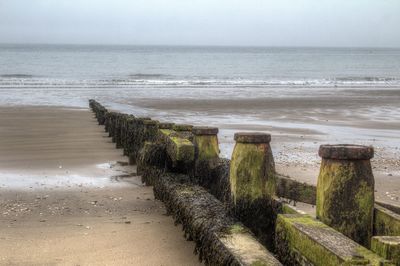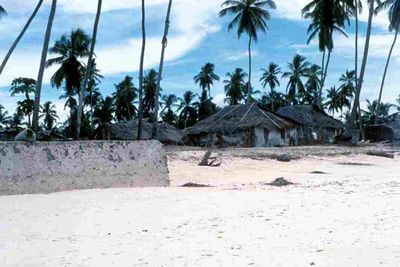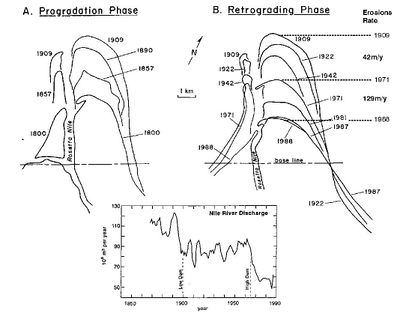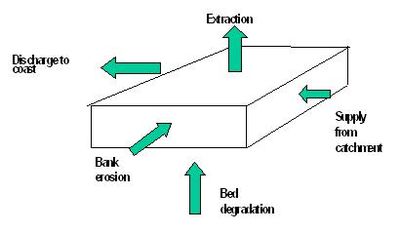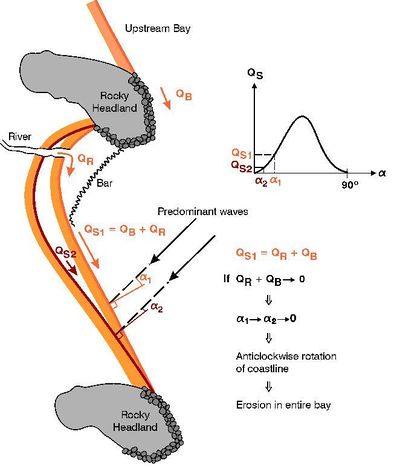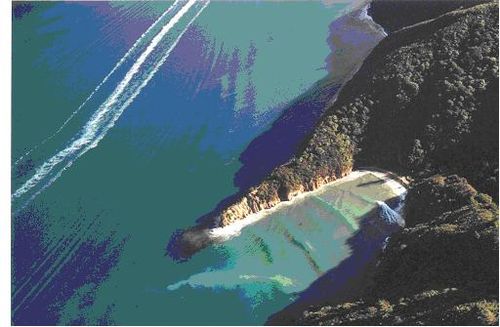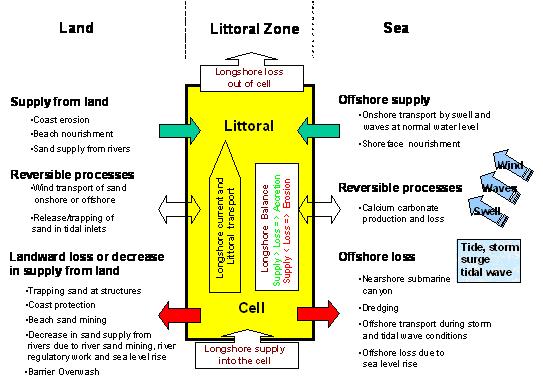Human causes of coastal erosion
The active coastal zone (planform and cross-shore profile of the subaqueous beach, the subaerial beach and adjacent dune) will always tend to a state of dynamic equilibrium. If some parts are highly resistant to erosion (presence of hard outcrops or cliffs, for example), this can take a very long time. However, if the active coastal zone consists exclusively of loose sediments, a state of dynamic equilibrium can be reached in rather short periods, of the order of years or decades. The longer periods hold for beaches in the vicinity of coastal inlets. The beach state at equilibrium is not static, but fluctuates around the equilibrium state in response to fluctuations in hydrodynamic factors (tidal cycles, wave climate) and sediment supply. These beach fluctuations correspond to alternating phases of erosion and accretion. Structural erosion or accretion can only happen in response to structural changes in the hydrodynamic conditions, in structural changes in sediment supply or in subsoil motion. These structural changes can have a natural cause or a human cause. Climate change, which influences sea level, wave climate and sediment supply, is considered a natural cause. The largest structural changes in hydrodynamic conditions and sediment supply are generally due to human interventions.
This article describes how different kinds of human interventions may affect coastal erosion. Natural causes of coastal erosion are discussed in another article. Most of the content of this article is drawn from Mangor et al. 2017 [1].
Contents
Interference with coastal structures
Coastal structures interfering with the littoral transport are the most common cause of coastal erosion. The presence of the structure has a series of effects (see Coastal Hydrodynamics And Transport Processes and Littoral drift and shoreline modelling):
- Trapping of sand at the upstream side of the structure that reduces sand supply to the adjacent shores. This causes mostly erosion at the lee side, but large structures may also cause (initial) erosion on the upstream side.
- Loss of sand to deep water.
- Trapping of sand in entrance channels and outer harbours. Sand is often deposited in deep water after being removed by dredging.
The structures, which may cause this type of erosion, are:
- Groynes and similar structures perpendicular to the shore.
- Ports (see also Port breakwaters and coastal erosion).
- Inlet jetties at tidal inlets and river mouths.
- detached breakwaters.
- Coastal reclamations.
The accumulation and erosion patterns adjacent to coastal structures depend among other things on:
- The wave climate and the orientation of the shoreline (see Classification of sandy coastlines)
- The extent of the structure relative to the width of the surf zone
- The detailed shape of the coastal structure
The typical impact on coastal processes and related shore erosion problems for different types of structures will be discussed briefly in the following. A more comprehensive description of the structures and their function is given in Hard coastal protection structures. The relation between structures and coastal erosion is also described in the articles: Dealing with coastal erosion, Port breakwaters and coastal erosion and Accretion and erosion for different coastal types.
Groynes and similar structures perpendicular to the shore
Groynes are normally built perpendicular to the shoreline with the purpose of protecting a section of the shoreline by blocking (part) of the littoral transport, whereby sand is accumulated on the upstream side of the groyne. However, sand trapping causes a deficit in the littoral drift budget, and this kind of coast protection is always associated with corresponding erosion on the lee side of the structure (Fig.1). In other words, a groyne just shifts the erosion problem to the downstream area. This is the reason that groynes are often built in long series along the shoreline, a so-called groyne field. In an attempt to compensate for the effect of the upstream groyne(s), new downstream groynes were built, which shifted the lee side erosion problem even further downstream.
The efficiency of a groyne field as a protection measure depends on the length of the groynes relative to the width of the littoral zone and the number and spacing of the groynes. A spacing of 1.5-3 times the groyne length is generally found to be most effective[2]. The more efficient the groyne field is protecting the shoreline within the groyne field, the more lee side erosion will be experienced downstream.
Besides, groynes generate or strengthen offshore-directed currents – so-called rip currents. These rip currents are dangerous for swimmers and transport sand to deeper water, enhancing sand deficit in the coastal zone [3]. These rip currents can be reduced by a T-shape design of the seaward end of the groyn [2].
These effects of groynes were not fully understood and realised at the beginning of the last century when most major groyne fields were constructed. Nowadays, this mechanism is understood and can be modelled and therefore groynes can be designed to fulfil their purpose optimally.
Apart from being beneficial to erosion impacts, groynes do not add to the beauty of the landscape.
Examples of coastline response to different types of groyne schemes are presented in the article on groynes as shore protection. Effects of groynes and different types of groynes are also presented in Groynes.
Ports built on the coast
The primary purpose of a port is to provide safe mooring and navigation for the calling vessels but when built on the shoreline it interferes with the littoral drift budget and the results are sedimentation and shoreline impact.
Like a groyne, the harbour moles of a port can block the littoral transport, by trapping sand at the updrift side in the form of an accumulating sand sheet. The sedimentation that occurs at the harbour entrance in the case of sand bypass requires maintenance dredging and deposition of the dredged sand. The result is a deficit in the littoral drift budget, which causes lee side erosion along the adjacent shoreline. A port on the coast must therefore be designed such that sedimentation and coastal impact is minimal. Attention has not always been paid to these requirements. The result is that many ports trap large amounts of sand and suffer from severe sedimentation (Fig.2).
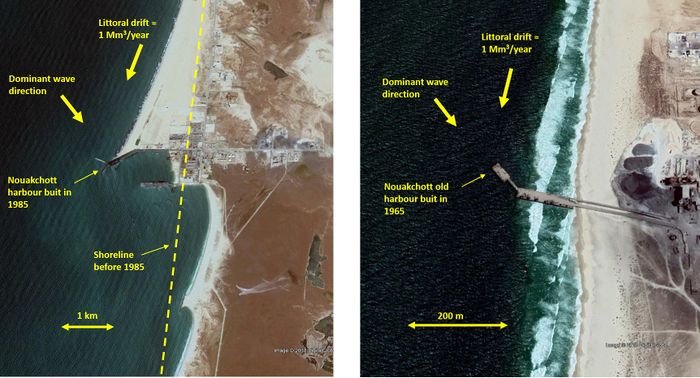
The principal shoreline development on coasts with oblique wave approach is discussed in Accretion and erosion for different coastal types. The effects of different types of ports on coastal erosion is also described in Port breakwaters and coastal erosion.
Inlet jetties at tidal inlets and river mouths
Tidal inlets and river mouths are often by nature shallow and variable in location, which makes them unsuitable for navigation. In order to improve navigation conditions and, to some extent, flushing conditions, many tidal inlets and river inlets have regulated mouths. The regulation may consist of jetties, possibly combined with maintenance dredging programmes. If the tidal inlets and the river mouths are located on littoral drift shorelines, they are often in a natural equilibrium with respect to bypassing of the littoral drift, which normally occurs on a shallow bar across the inlet. If the inlet/mouth is upgraded to accommodate navigation, this bar is normally cut off by the jetties or dredged.
For the above reasons, regulated inlets are normally obstructions to the littoral transport which means upstream sand accumulation along the upstream jetty, loss of sand due to sedimentation in the deepened channel and the associated maintenance dredging. All in all, regulated inlets will very often cause lee side erosion problems. Legislation requiring mitigation measures, such as artificial sand bypass, is not always respected. At many such locations mitigation measures have never been introduced or severely delayed.
In conclusion, past and present regulations of tidal inlets and river mouths are responsible for major erosion along many coastlines throughout the world. See also Typical examples of structural erosion and Port breakwaters and coastal erosion.
Detached breakwaters
Detached breakwaters are used as shore and coast protection measures. In general terms, a detached breakwater is a coast-parallel structure located inside or close to the surf-zone. As this subject is too extensive for this page, see Detached breakwaters for a detailed discussion on the subject.
Seawalls and revetments
Other types of coastal protection that do not protrude into the sea will, however, also cause increased coastal erosion. Seawalls and revetments are typically constructed along coastal sections to provide protection of the coast. Seawalls are alongshore structures built as vertical walls, as sea dikes with smooth sloping stone revetments, as geotubes or as rip-rap concrete blocks or rock. Coasts protected by seawalls are called 'armoured coasts'.
The impact of seawalls on coastal erosion depends, among other things, on the location of the structure in the coastal profile, on the littoral drift and on the natural beach evolution [4].
In the case of a naturally accreting coast, the main reason for building a seawall is to protect coastal settlements from storm surge damage or to protect low-lying hinterland from flooding. The seawall is usually fronted by a wide beach and its impact on beach dynamics is negligible.
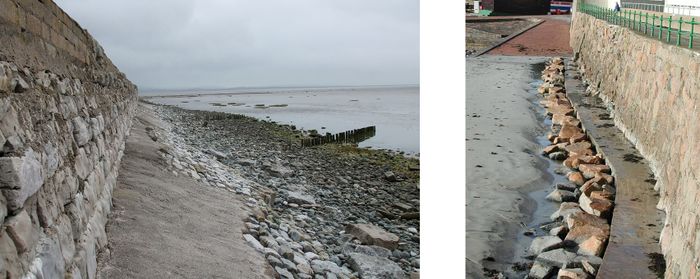
Seawalls are built most often on eroding coasts; their primary function is to stop erosion. However, the erosion process seaward of the structure continues and may even be enhanced. After some time no beach will be left in front of the seawall. At that stage the toe of the seawall will be scoured by waves and the structure will collapse if the toe is not sufficiently protected [5] (Fig.3). Whether a seawall enhances erosion before the beach has disappeared (so-called 'active erosion') is site dependent. Active erosion increases with decreasing beach width. Three processes play a role:
- Beach lowering by enhanced wave energy dissipation at the toe of the seawall. This process is significant in the case of frequent wave attack on the seawall or insufficient sand supply by littoral drift for beach recovering after storm erosion [6][7].
- Enhanced beach lowering and shoreline retreat after storm erosion [8]. In the case of a non-armoured dune coast, sand is supplied to the beach from dune erosion, whereas in the case of an armoured coast, dune sand is retained behind the seawall. However, this effect is not always observed and may be temporary. Basco (2004) [9] found that for a 2m/year retreating beach at Virginia "the seasonal variability of sand volume in front of walls was slightly greater than at non-walled locations. Winter season waves dragged more sand offshore in front of walls but summer swell waves piled more sand up against walls in beach rebuilding. Walled beaches were found to recover about the same time as non-walled beaches for both seasonal transitions (winter to summer) and following erosional storm events."
- Erosion at the leeside of the seawall, after the front beach has disappeared [10] [11]. An eroding shore/coast supplies material to the littoral transport budget if the erosion is allowed to continue. When the erosion is stopped at certain sections by the construction of seawalls or revetments, the supply of sand from this section of the shoreline to the sediment budget along the adjacent sections of shorelines will stop, whereby these adjacent shorelines will be exposed to increased erosion (Fig.4). The active trapping structures, such as groynes and breakwaters, will also act in this way in addition to their more direct coastal impact as discussed above.
The erosion of soft cliffs often appears to be very drastic, which is why they have, in many cases, been the first to be protected in an area. However, before their protection they were the main suppliers of sediments to the littoral cell in question. Consequently, their protection leads to increased erosion at adjacent lower sections of the coastline. The result is that the erosion has been shifted to less resistant areas resulting in higher area losses per year.
Another impact of seawalls is the reduction of aeolian transport for the formation and extension of a coastal dune belt [12].
Other relevant articles on this topic are Seawall, Revetments and Seawalls and revetments.
Erosion due to decrease of fluvial sand supply
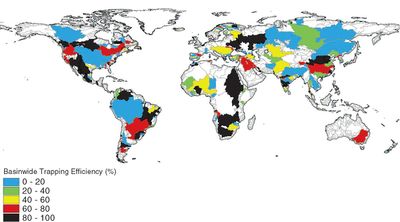
Decrease of fluvial sand supply to the coastal zone is a common cause of coastal erosion. Reduction of fluvial sand supply can result from different human interventions:
- creation of reservoirs for power production and irrigation purposes by the construction of river dams,
- deepening of navigation channels,
- mining of river sand.
River dams
Thousands of dams have been constructed on rivers worldwide, creating reservoirs which retain a large part of the sediment discharge from the catchment areas (Fig.5). Perhaps the best-known example of coastal erosion related to sediment trapping behind a river dam is the erosion of the Nile Delta coast after the construction of the High Aswan Dam in the 1960´s, see Fig.6. The promontory propagated until 1909 and then began to erode. The reasons for the erosion of 42 m/year during the period 1909-1971 were mainly a reduction in the river discharge and the construction of the Low Aswan Dam, whereas the drastically increased erosion rate of 129 m/year after 1971 was caused by the construction of the High Aswan Dam.
Sand mining in rivers
Sand mining in rivers is a major cause of coastal erosion in many countries. Sand mining in a river lowers the river bed, causes bank erosion and reduces the supply of sand to the coast. There are five components in the sediment balance for a degrading river section, schematically represented in Fig.7.
The components are:
Sources:
- Sand supply from the catchment, Qcatch
- Lowering of the river bed, Qbed
- Bank erosion, Qbank
Sinks:
- Sand extraction (sand mining), Qmining
- Sand discharge to the coast, Qcoast
The average sediment discharge to the coast follows from the following equation:
[math]Q_{coast} = Q_{catch}\, + Q_{bed}\, + Q_{bank}\, - Q_{mining}[/math]
Many rivers consist of a steep upper part, the mountain part, and a gently sloping lower part, where the river crosses the coastal plain. Sand extraction in the upper part of the river causes lowering of the river bed and a similar lowering of the water level, hence no changes in the sediment transport capacity. Thus the sand extraction in the upper part of the river is almost entirely balanced by local bed degradation, and has hardly any immediate impact on the supply of sand to the coast. Sand mining in the lower part of the river at some distance from the river mouth causes a local lowering of the river bed. However, the water level will not lower as much, which results in a local decrease in the flow velocity and in the sediment transport capacity. The river bed depression will gradually be filled in from upstream supply and will travel towards the coast. When the impact of sand mining reaches the coast there may be an accumulated deficit in available river bed material corresponding to several decades sediment supply from the catchment. This means that an immediate halt in the sand mining will have hardly any remedial effect on the supply of sand to the coast, as the entire river bed has to rebuild before the original supply is re-established. Sand mining close to the river mouth causes an immediate decrease in the supply of sand to the coast, and halt of the sand mining in this situation will quickly cause recover of the supply of sand to the coast. These impacts of sand mining on coastal sediment supply are observed in many rivers, for example for rivers in Sri Lanka [14].
Coastal erosion is not the only impact of river sand mining. Other impacts also have to be taken into consideration:
- Deeper penetration of the tide into rivers and estuaries and increased saline intrusion, especially during the dry season; this may cause troubles for water intakes and for irrigation and cause changes to the estuarine habitats.
- Increased flooding origination from the sea.
- Lowering of the beds of the rivers also cause lowering of the water level in the rivers, affecting the ground water table in the flood plains. This may have impact on agriculture especially during the dry period. It also causes problems for intakes to older irrigation schemes as they are now above the water level in the river.
- Lowering of the river bed is in general less uniform along the river than the corresponding lowering of the water level. This may cause problems for navigation, especially when river discharge is low.
- Reduction of flood levels for small and medium sized floods, because the deepened river bed and the low water level provides more volume between the river banks. However, extreme floods will still spread over the flood plains. The absence of regular "small" inundations is likely to enhance man's encroachment on to the flood plain, thus causing increased "flooding problems" when the real large floods occur.
Hence, river sand mining requires an integrated approach taking into account all the impacts. This calls for close collaboration between river authorities and coastal authorities.
Erosion of bays enclosed between headlands
Small sandy bays enclosed between headlands have in general a crescentic shape, which is due to wave diffraction at the headlands and wave refraction in nearshore shallow water (see Shallow-water wave theory). However, the shape and position of the shoreline depends not only on the wave climate, but also on sand supply to the bay. There are two possible sources (see Fig.8):
- Sand from another bay passing by littoral drift along one of the headlands, QB;
- Sand supply from a river, QR.
The overall transport mechanisms in a crescent-shaped bay can be characterised as follows. The supply of sand from the upstream bay QB will pass the headland and cross the bay via a bar. If a river also contributes QR to the littoral budget, this material will be transported downdrift into the bay, partly along the shoreline and partly onto the bar. These transport processes are fairly complicated and 2-dimensional in nature, but they result in the supply of QB + QR to the straight downdrift section of the crescent-shaped shoreline of the bay. The direction of this straight section is given by the wave climate and the actual sum QS1 = QB + QR according to the transport correlation between incident wave direction α1 and the transport QS1, shown in Fig.8 (The dependence of littoral drift on the wave incidence angle is explained in Shallow-water wave theory and Littoral drift and shoreline modelling).
The shape of the crescent-shaped bay is stable, apart from seasonal variations, as long as the supply of material to the bay QS1 is not changed. However, if the supply of material to the bay is reduced, typically by changes to the updrift bay or by changes to the river, the overall shape of the bay will also change, as the direction of the straight section will adjust to the new sum Q2, where Q2 < Q1, leading to erosion in the entire bay, as sketched in Fig.8.
This means that human interventions, which cause changes in one bay will gradually penetrate into the downdrift bays. Hence, crescent-shaped bays, although they appear fairly stable, are actually very sensitive to interventions that modify the supply of sand.
Wake from Fast Ferries
Wakes from fast ferries cause shore degradation in sheltered coastal environments [15][16]. The special wake generated by fast ferries is characterised by a series of approximately 10 relatively low waves (significant wave height below 1 m), but relatively long waves. These wake waves are very similar to swell waves and they are exposed to considerable shoaling when approaching the coast. They often break as plunging breakers.
If a fast ferry navigates through protected waters, the wake waves are very different from the natural waves along the navigation route. The wake waves caused by fast ferries may influence coastal conditions in the following ways:
- by higher wave uprush than that produced by normal waves;
- by changing the coastal morphological processes in the area. This can result in erosion as well as the formation of a large beach berm;
- by breaking unexpectedly and violently, the waves can be dangerous for dinghies and for bathers.
A precondition for approval of a new fast ferry route is therefore to perform an environmental impact assessment study [17]. This will often result in navigation restrictions for certain parts of the route. An example of the impact of such waves is presented in Fig.9. Note the violent breaking, turbid water and rip currents.
Sand and Coral Mining, and Maintenance Dredging
The mining of sand and gravel along beaches and in the surf-zone will cause erosion by depleting the shore of its sediment resources. In connection with maintenance dredging of tidal inlets, harbours, and navigation channels, sand is very often lost from the littoral budget because the sand, unless otherwise regulated by legislation, is normally dumped at deep water. Coral mining and other means of spoiling the protective coral reefs, for example, fishing by the use of explosives or pollution, will also cause coastal erosion and beach degradation. The protective function of the reef disappears and the production of carbonate sand stops.
Concluding Remarks
In conclusion, it can be seen that nearly every type of development and coastal protection along a littoral shoreline or along rivers will result in erosion of the adjacent shores and coasts.
An overview of sediment sources and losses to the coastal zone is presented in Fig.10.
Related articles
For more information on the background of coastal erosion:
- Dealing with coastal erosion
- Erosion hotspots
- Littoral drift and shoreline modelling: 1-line model for shoreline response to gradients in littoral drift.
- Natural causes of coastal erosion: causes of erosion, such as transport gradient, loss of sand, sea level rise and subsidence.
- Coastal Hydrodynamics And Transport Processes: hydrodynamic background of the movement and transport of sediment
For more information on the relation between human intervention and coastal erosion:
- Accretion and erosion for different coastal types: Erosion caused by a large port for different types of coasts
- Port breakwaters and coastal erosion: Effects of breakwaters from different types of ports (isolated, river mouth in the sea, mouth of a large estuary) on coastal erosion
References
- ↑ Mangor, K., Drønen, N. K., Kaergaard, K.H. and Kristensen, N.E. 2017. Shoreline management guidelines. DHI https://www.dhigroup.com/marine-water/ebook-shoreline-management-guidelines
- ↑ 2.0 2.1 van Rijn, L., 2011. Coastal erosion and control. Journal of Ocean and Coastal Management, 54(12), 867–887.
- ↑ Castelle, B., Scott, T., Brander, R.W. and McCarroll, R.J. 2016. Rip current types, circulation and hazard. Earth-Science Reviews 163: 1-21
- ↑ Weggel, J.R., 1988, Seawalls—The need for research, dimensional considerations and a suggested classification, in Kraus, N.C., and Pilkey, O.H., eds., The Effects of Seawalls on the Beach: Journal of Coastal Research Special Issue 4, p. 29–40.
- ↑ Bradbury, A., Rogers, J. and Thomas, D. 2012. Toe structures management manual. Environment Agency
- ↑ Kraus, N. C. 1988. The effects of seawalls on the beach: a literature review. Proceedings of Coastal Sediments '87, American Society of Civil Engineers, 945-960.
- ↑ Sutherland, J., Brampton, A.H., Obhrai, C., Dunn, S. and Whitehouse, R.J.S. 2007. Understanding the Lowering of Beaches in front of Coastal Defence Structures, Stage 2. R&D Technical Report FD1927/TR. Joint Defra/EA Flood and Coastal Erosion Risk Management R&D Programme
- ↑ Griggs, G.B., and Tait, J.F., 1990, Beach response to the presence of a seawall—A comparison of field observations: Shore and Beach, v. 58, no. 2, p. 11–28
- ↑ Basco, D.R., 2004. Seawall impact on adjacent beaches: Separating fact from fiction. In: Klein, A.H.F.; Finkl, C.W., and Diehl, F.L. (eds.), The International Coastal Symposium (ICS 2004; Brazil). Journal of Coastal Research, Special Issue No. 39, pp. 741–744.
- ↑ Dean, R. G. 1986. Coastal armoring: effects, principles and mitigation. Proceedings of 20th Coastal Engineering Conference, American Society of Civil Engineers, 1843-1857.
- ↑ Komar, P D. and McDougal, W.G., 1988. Coastal erosion and engineering structures: The Oregon experience. In: Kraus, N.C. and Pilkey, O.H. (eds.), The Effects of Seawalls on the Beach. Journal of Coastal Research, Special Issue No. 4, pp. 77–92.
- ↑ Nordstrom, K.F. 2014. Living with shore protection structures: A review Estuarine, Coastal and Shelf Science 150: 11-23
- ↑ Vorosmarty, C. J., Meybeck, M., Fekete, B., Sharma, K., Green, P. and Syvitski, J.P.M. 2003. Anthropogenic sediment retention: major global impact from registered river impoundments. Global and Planetary Change 39: 169–190.
- ↑ Mangor, K., 2002. Shoreline Management, Background Document for the second revision of the Coastal Zone Management Plan, Sri Lanka, 2002. Performed under the Coastal Resources Management Program, Sri Lanka. ADB TA No. 3477 SRI
- ↑ Bilkovic, D., Mitchell, M., Davis, J., Andrews, E., King, A., Mason, P., Herman, J. and Tahvildari N. 2017. Review of boat wake wave impacts on shoreline erosion and potential solutions for the Chesapeake Bay. STAC Publication Number 17-002, Edgewater, MD. 68 pp.
- ↑ Zaggia, L., Lorenzetti, G., Manfé, G., Scarpa, G.M., Molinaroli, E., Parnell, K.E., Rapaglia, J.P., Gionta, M. and Soomere, T. 2017. Fast shoreline erosion induced by ship wakes in a coastal lagoon: Field evidence and remote sensing analysis. PLOS ONE 12(10): e0187210.
- ↑ Glamore, W.C. 2005. A Decision Support Tool for Assessing the Impact of Boat Wake Waves on Inland Waterways. PIANC paper https://www.pianc.org/downloads/dwa/Wglamore_DPWApaper.pdf
Please note that others may also have edited the contents of this article.
|
